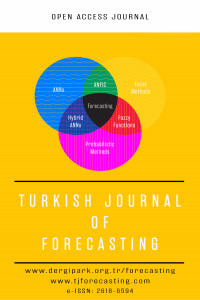A Fuzzy Modelling Approach to NSE Criterion on Robust Design
A Fuzzy Modelling Approach to NSE Criterion on Robust Design
Dual response methodology is a natural and effective tool for a reliable and robust operation process or product in modern quality engineering. Therefore, many of quality improvement techniques based on dual response methodology focus on being on target and reducing system variability. This paper presents a fuzzy modelling approach based on the Nash-Sutcliffe efficiency for a dual response problem. The proposed approach aims to determine a set of operating conditions that maximize the degree of satisfaction due to the Nash-Sutcliffe efficiency in a quality improvement context. Additionally, the proposed approach is illustrated with a well-known design of experiment by comparing existing methods.
___
- [1] G.E.P. Box and K.B. Wilson, On the Experimental Attainment of Optimum Conditions, J. Roy. Statist. Soc. Ser. B Metho. 13 (1951) 1-45.
- [2] G.G. Vining and R.H. Myers, Combining Taguchi and Response Surface Philosophies: A Dual Response Approach, J. Qual. Technol. 22 (1990) 38-45.
- [3] E. Del Castillo and D.C. Montgomery, A Nonlinear Programming Solution to the Dual Response Problem, J. Qual. Technol. 25 (1993) 199-204.
- [4] D.K.J. Lin and W. Tu, Dual Response Surface Optimization, J. Qual. Technol. 27 (1995) 34-39.
- [5] K. Kim and D.K.J. Lin, Dual Response Surface Optimization: A Fuzzy Modeling Approach, J. Qual. Technol. 30 (1998) 1-10.
- [6] M. Zeybek and O. Köksoy, A Fuzzy Modelling Approach to Robust Design via Loss Functions, Turkish Journal of Forecasting. 01 (2017) 40-45.
- [7] A.C. Shoemaker, K.L, Tsui, and C.F.J. Wu, Economical Experimentation Methods for Robust Parameter Design, Technometrics. 33 (1991) 415-427.
- [8] K.A. Copeland and P.R. Nelson, Dual Response Optimization via Direct Function Minimization, J. Qual. Technol. 28 (1996) 331-336.
- [9] J.M. Lucas, How to Achieve a Robust Process Using Response Surface Methodology, J. Qual. Technol. 26 (1994). 248-260.
- [10] O. Köksoy and N. Doganaksoy, Joint Optimization of Mean and Standard Deviation in Response Surface Experimentation, J. Qual. Technol. 35 (2003) 239-252.
- [11] O. Köksoy, Multiresponse Robust Design: Mean Square Error (MSE criterion), Appl. Math. Comput. 175 (2006) 1716-1729.
- [12] A.H. Murphy, Skill Scores Based on the Mean Square Error and Their Relationships to the Correlation Coefficient, Mon Weather Rev. 116 (1988) 2417-2424.
- [13] S. Weglarzyk, The Interdependence and Applicability of Some Statistical Quality Measures for Hydrological Models, J Hydrol. 206 (1998) 98-103.
- [14] H.V. Gupta, H. Kling, K.K. Yilmaz and G.F. Martinez, Decomposition of the Mean Squared Error and NSE Performance Criteria: Implications for Improving Hydrological Modelling, J Hydrol. 377 (2009) 80-91.
- [15] H.J. Zimmermann, Fuzzy Sets, Decision Making, and Expert Systems, Kluwer Academic Publishers, Boston, M.A. (1987).
- [16] C.W. Kirkwood, Strategic Decision Making, Duxbury Press, Belmont, C.A. (1996).
- [17] H. Moskowitz and K. Kim, On Assessing the H Value in Fuzzy Linear Regression, Fuzzy Sets Syst. 58 (1993) 303-327.
- [18] G.E.P. Box and N.R. Draper, Empirical Model Building and Response Surfaces, John&Sons, New York, N.Y. (1987).
- Yayın Aralığı: Yılda 2 Sayı
- Başlangıç: 2017
- Yayıncı: Giresun Üniversitesi
